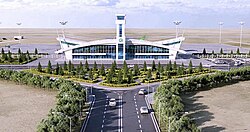Atamurat
Kerki
Place in Lebap Province, Turkmenistan
Kerki is a city in and capital of Kerki District, Lebap Province, Turkmenistan. It was formerly known as Zamm[1] and, between 1999 and 2017, as Atamyrat.
You can help expand this article with text translated from the corresponding article in Russian. Click [show] for important translation instructions.
|

